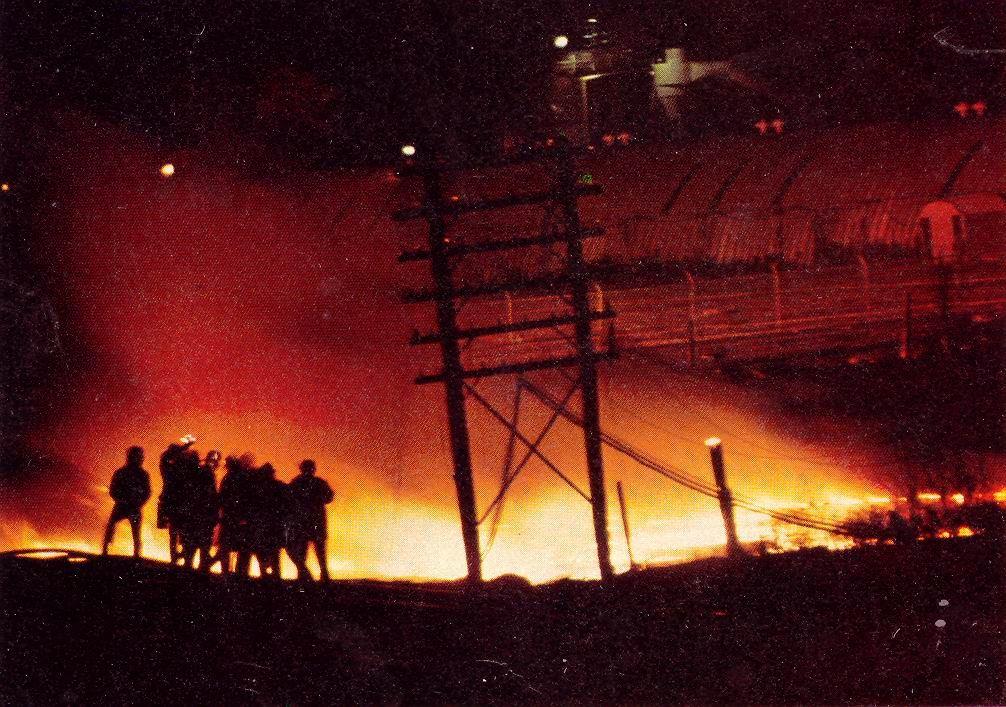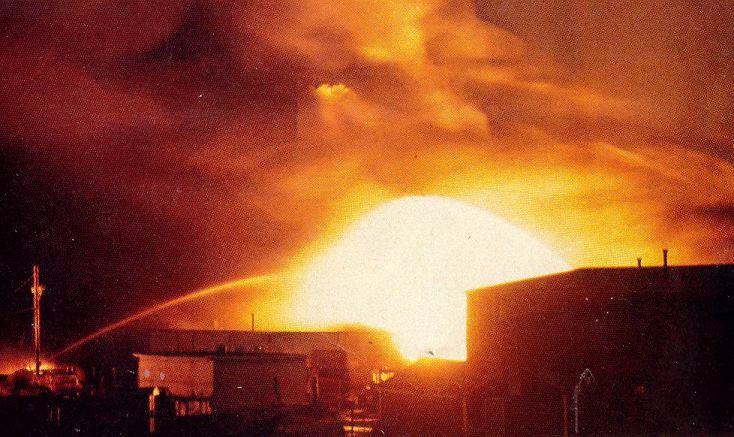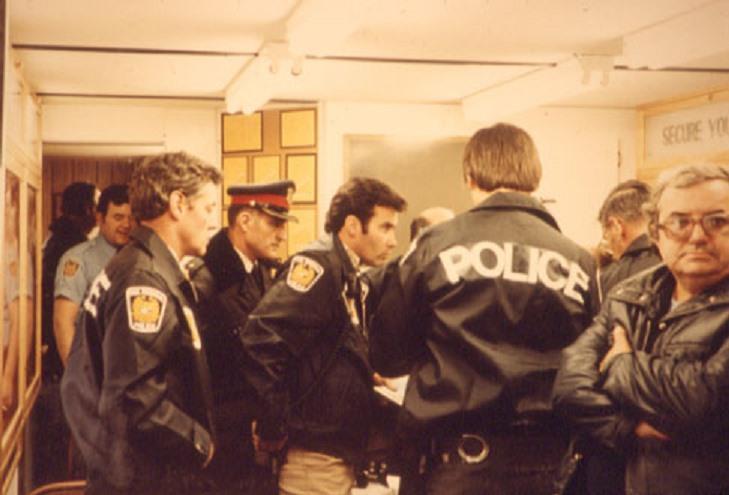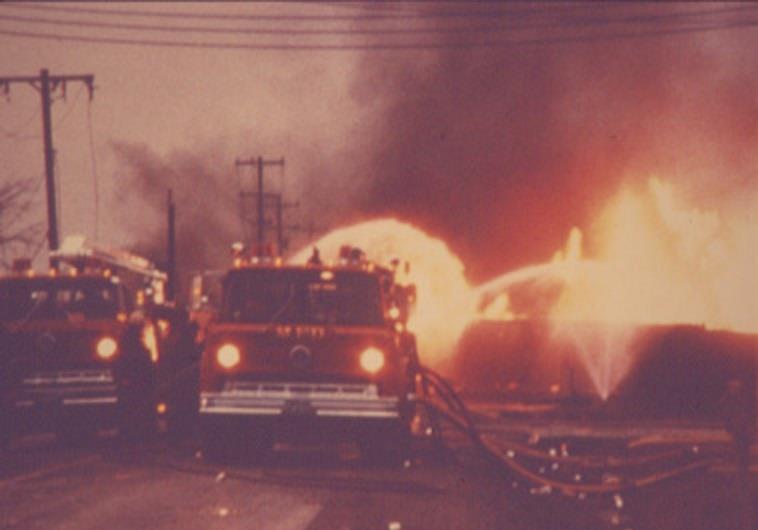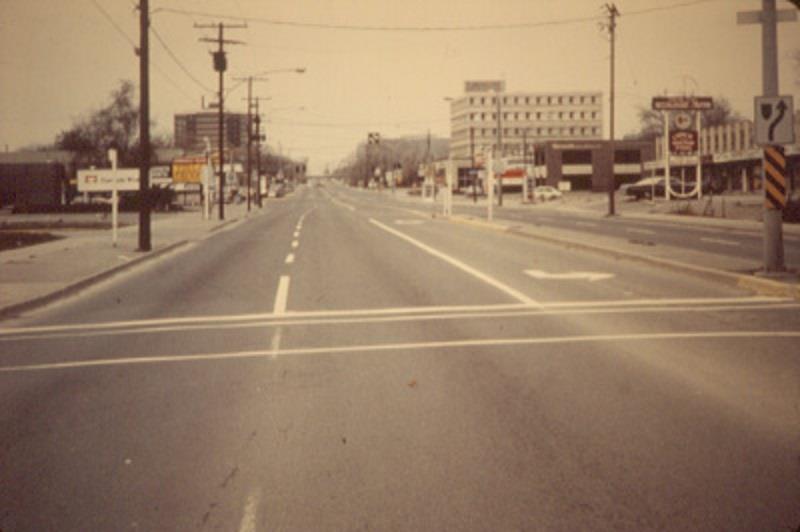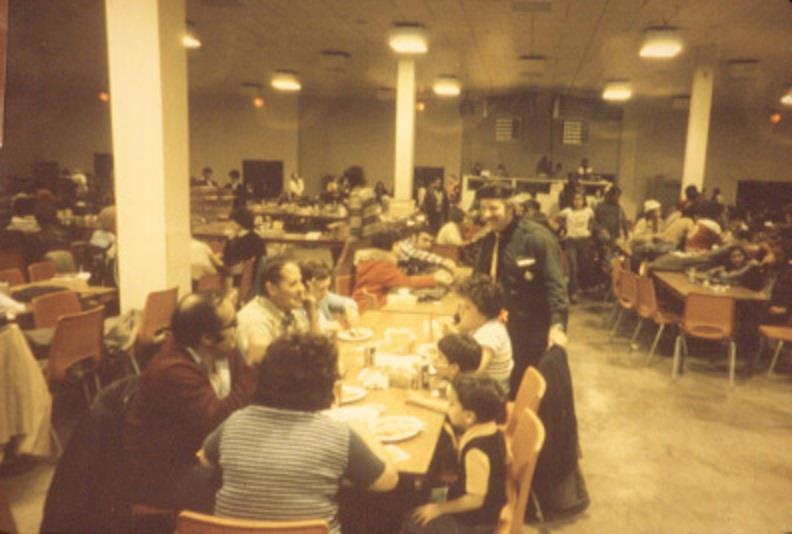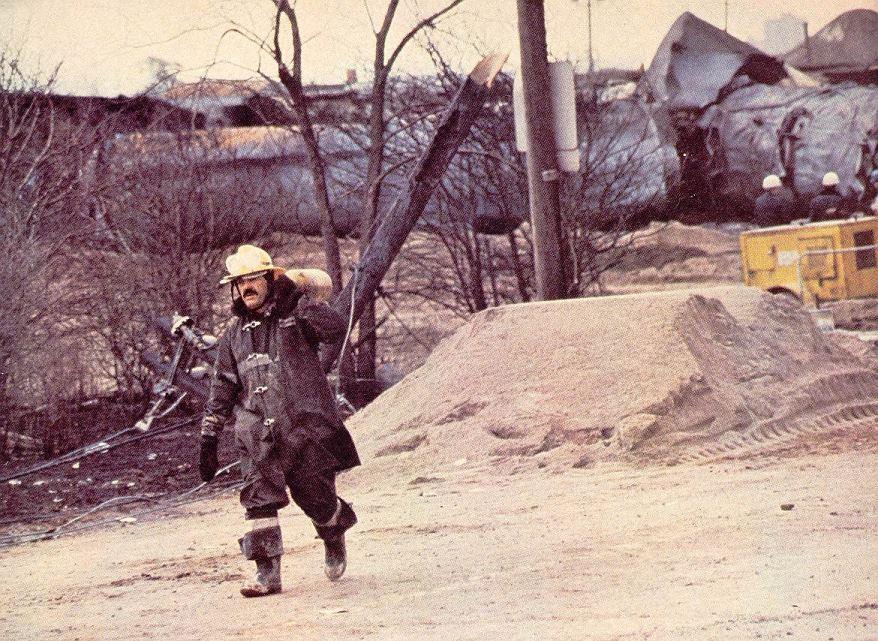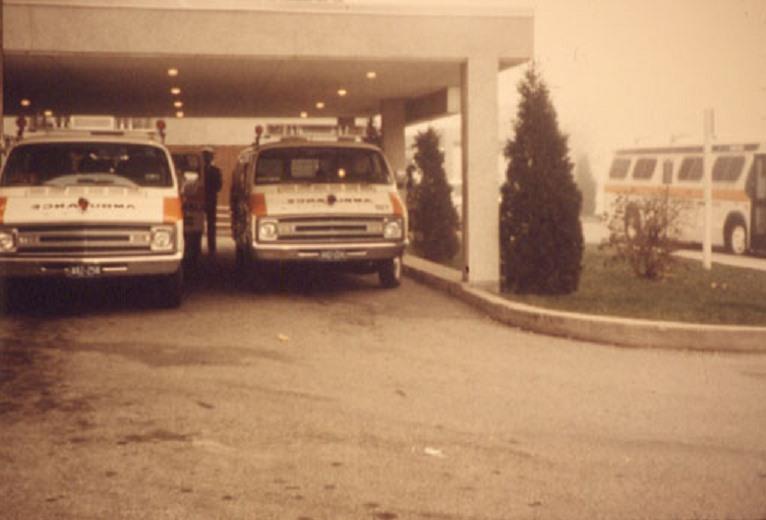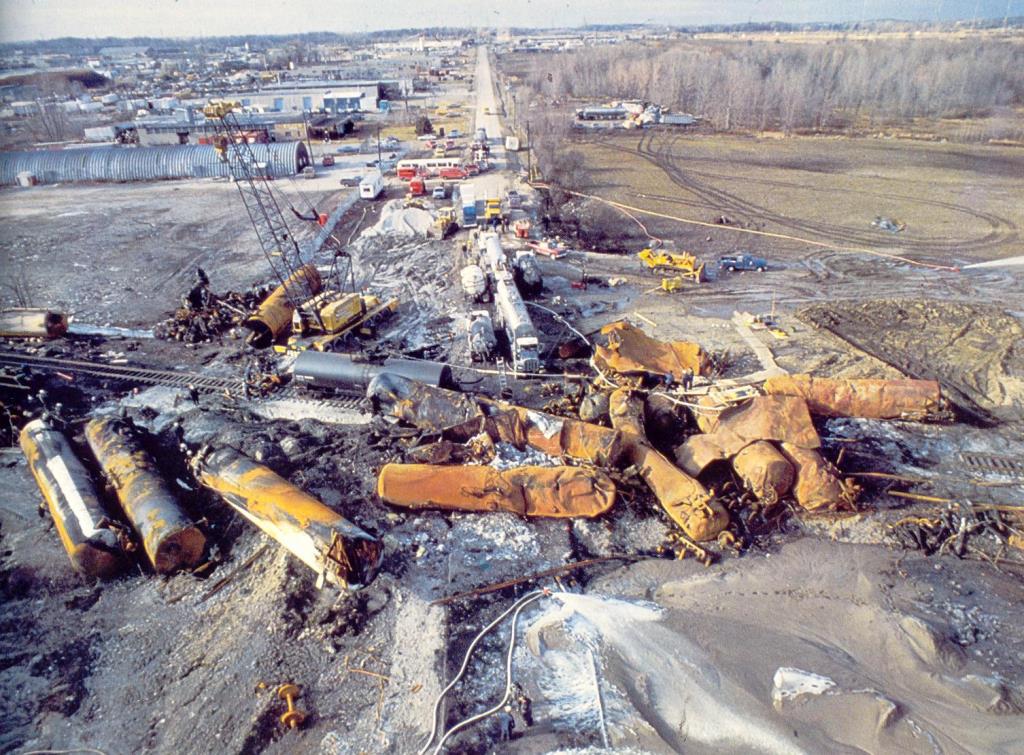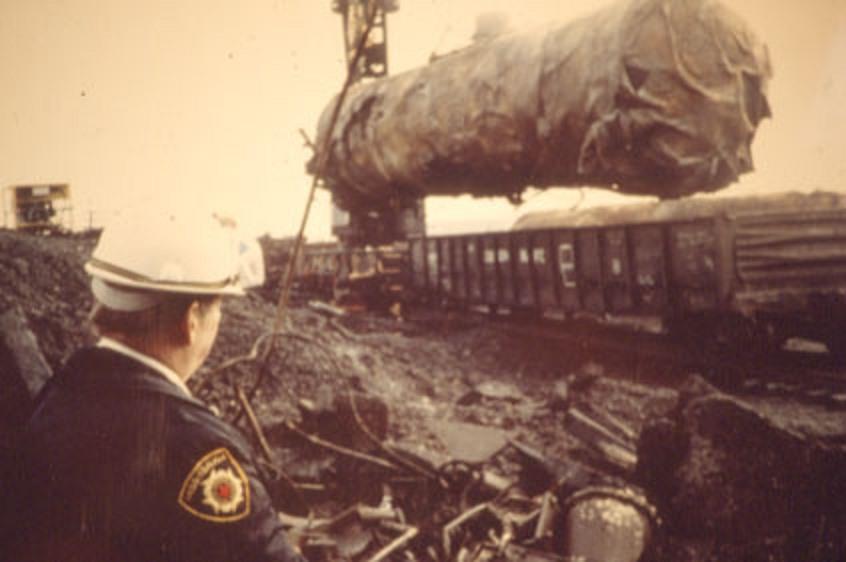Mississauga Train Derailment
November 10, 1979
Day 1
CP Train 54 began as a string of freight cars on the Chesapeake and Ohio Railroad in the Northern United States. The train crossed into Canada to collect more cars at Sarnia and Chatham, in Southern Ontario. Among them was a tanker filled with 90 tons of chlorine. Thirty-nine more cars were added, loaded with butane, propane, toluene, styrene and other highly flammable materials. As the 106-car train rolled out of the Chatham marshalling yards on November 10th, the three-man crew had nothing to indicate it would be anything but an uneventful run to Toronto. Train 54, drawn by its three locomotives, bored into the night at 80 kph. And then it happened …
11:53 pm – As the train rushes over the Burnhamthorpe Road level crossing, there is a loud bang. Lynne Riddel, of Freeport Crescent, sees a red-hot set of wheels from the train cartwheel 50 feet through the air and crash into her backyard.
11:56 pm – Three kilometres down the track, Ron Dabor nears the Mavis Road crossing in his car. His wife, Kay, notices sparks flying from Train 54. They begin to count the cars. They reach 27 and, then, amid a screeching of tearing metal, tankers in the train begin to smash into each other and 25 topple from the rails. Dabor quickly stops, then reverses at full speed. As their car goes into a ditch, the couple leapt out to flee the orange fireball that erupted 1000 feet into the night sky. In the lead locomotive, the air pressure falls and the brakes on the train lock automatically. Brakeman, Larry Krupa, cries to his father-in-law, engineer Keith Pruss: “Oh, my God, we’ve got a tanker afire!” They see flames shooting 40 storeys high as tankers explode in a roar of gaseous fury.
11:57 pm – Every available piece of firefighting equipment in Mississauga is ordered to the blaze. 27 cars, many with explosive and flammable contents, are still hitched to the train.
11:58 pm – Brakeman Larry Krupa runs toward the flames, uncouples two tankers, enabling his father-in-law to pull the 27 cars away from the searing heat. The remains of Train 54 stop seven kilometres down the line. Krupa is recommended for the Order of Canada for his bravery.
12:01 am – A second explosion. The flash is seen as far away as Niagara Falls, Oshawa and Peterborough. The noise awakens tens of thousands throughout Toronto. The blast was so powerful that one tanker is hurled a kilometre away. Firefighters do their best, but can make no impression on the raging flames. Eleven of the derailed tankers contain highly-explosive propane, and one tanker held the 90 tons of chlorine.
1:30 am – As the location of the chlorine tanker become known, a shudder of fear runs through the fire and civil defence chiefs. They know that the heat can change chlorine gas into even-deadlier phosgene – the gas that killed thousands of soldiers in the First World War. Peel Regional Police Chief Doug Burrows give the order: “Evacuate!” Immediately, police start to rouse and move out 6000 people living in the immediate area, the start of what is to become the largest evacuation ever in North America.
2:15 am – The provincial ambulance co-ordination centre calls in all off-duty personnel.
4:00 am – A third explosion as more propane tankers go up. A second wave of evacuations is ordered. 20,000 people leave their homes and 7000 more are sheltered at Square One.
6:00 am – The chlorine is leaking! A 3 foot hole is glimpsed by firefighters in the side of the tanker, just as they begin to gain some control over the blazing inferno. They allow for a controlled burn to dissipate the explosive gases while keeping their hoses on the chlorine tanker to prevent it from heating and exploding.
8:30 am – Attorney-general Roy McMurty, head of the provincial government’s emergency planning committee, arrives on the scene.
9:35 am – buses and ambulances line up to evacuate patients from the Mississauga Hospital.
9:50 am – The wind increases and evacuation boundaries are again expanded.
10:00 am – Two explosions as another tanker ignites. Firefighters continue to valiantly battle the inferno.
12:30 pm – Evacuees who went to Square One are moved farther away, to Sherway Gardens.
1:00 pm – Experts from Dow Chemical Company in Sarnia arrive. Computers are used to produce weather forecasts and the evacuation boundary is expanded again.
1:35 pm – The evacuation of all persons is ordered from an area bounded by the Credit River, Burnhamthorpe Road, Cawthra Road and the Lakeshore. 70,000 people have had to flee the 25 square mile area.
3:40 pm – The sixth evacuation order clears an area from Royal Windsor Drive to Dixie Road. By 6:00 pm, orders are given to evacuate Queensway General Hospital and all nearby nursing homes. The evacuees who went to Sherway Gardens are told they must move yet again, to the International Trade Centre on Airport Road.
9:00 pm – The evacuation zone is expanded yet again, from Ninth Line to the Etobicoke Creek. By 11:00 pm, the evacuation order has spread to Oakville as far as Maple Grove Road and the Oakville-Trafalgar Hospital is evacuated.
12:00 am – By midnight, the evacuation total reached 250,000 people.
Day 2
12:30 am – Mississauga Mayor Hazel McCallion orders that no-one is to be found in the city. Mississauga is, she said, “Closed until further notice.”
1:30 am – Hamilton and the western part of Toronto are placed on alert for possible evacuation. By 4:10 am, the evacuation of 3000 Oakville residents is completed.
Day 3
Dawn – The fires in the wreckage finally go out. Experts estimate that 75% of the chlorine has escaped into the atmosphere.
1:00 pm – 11,000 evacuees are allowed to return to their homes – and results in a massive, seven-hour traffic jam at the Trafalgar Road exit from the QEW. Work proceeds on draining the propane tankers.
Day 4
Each hour, 35 lbs of chlorine continued to leak from the damaged tanker as chemical workers spent a frustrating day trying to patch the hole. There is a scare when a large, white cloud escapes the tanker. During the night, pumping out of the chlorine begins.
Day 5
Pumping of the chlorine continues. Eight firefighters walk into a pocket of chlorine gas near the wrecked tanker and are admitted to hospital.
Day 6
Work crews succeed in draining almost all of the remaining liquid chlorine – 14 tons – from the crippled tanker. More than half of the remaining 33,000 evacuees return home. At 7:42 pm, the last evacuation order is lifted and the remaining evacuees are told they can go home, thus ending the largest evacuation in North American history without a single loss of life!
Quotes on the Mississauga Train Derailment
“I had my back to the wreck and she blew. My hair was singed. I felt I was dead.”
-Bob Barridge, first policeman on the scene of derailment.
“I thought it was a nuclear attack. I was sure it was the end. I had gone to bed just before midnight … when all hell broke loose. I jumped out of bed and looked out the window. The sky was lit up with a huge orange flame.”
-Alphy McCann, Mississauga resident.
“There was a brilliant orange light that turned night into day.”
-Cal Miller, Mississauga resident and first newsman on the scene.
“We heard a major explosion … we watched as a tanker car was projected hundreds of feet into the air … the sky was burning red …”
-Charlene Heath, Downsview resident.
“The sky looked like the “Tea Party” from Alice in Wonderland. The sky was rosey pink and in constant motion across the horizon.”
-Sue Zoerb, Mississauga resident.
“It’s impossible to describe the anxiety we had on having to leave our homes, and on not being allowed back into our homes.”
-Gertrude Hammill, Mississauga resident.
“People were refugees … it was a time of generosity and pulling together by everyone. It put Mississauga on the world map in a very flattering way.”
-Lorne Smith, Mississauga resident.
“The thing I remember most was driving bumper to bumper on the QEW into Toronto was looking into the other cars. Everyone shared a common bond.”
-Jenny Dale, Mississauga resident.
“We were very thankful for friends taking us in.”
-Mr. & Mrs. G. Andries
“My first thought was that a plane went down … I remember that the first blast woke me up in Malton, and I saw the second fireball from my apartment … it was a scary situation.”
-Tom Godden, Mississauga resident.
“We drove across the Mavis Road rail crossing on our way home … later, we were chilled to think how close we had come to being in the midst of it.”
-John Emerson, Streetsville resident.
“It was horrific. Our house shook. The windows rattled. The sky was bright orange, and when I saw the fireball, we were already running to the car, only with the clothes we had on, and on our way out of the city. We didn’t even know where we were going.”
-John McGlashen, Mississauga resident, lived three blocks from derailment.
“It wasn’t a disaster; it wasn’t a tragedy. But it could have been. It was heroic, in that everyone performed well. Mississauga and its citizens were tested, and came through. Magnificently.”
-Peter Worthington.
“There was a deafening roar, a brilliant glow and intense heat as I stepped out from a building that shielded me from the flaming train wreck. I dropped to my stomach and pressed my body close to the building. The day-like glow lasted for about a minute and soon the roof of the building that protected me was afire.”
-Cal Millar, Toronto Sun Staff Writer, lived closed to the derailment site.
“We took a few seconds to assess the situation … it was just a wall of fire, as high as you could see. (The first explosion) blew me down, simply threw me in a way I’ve never felt before. As I lay there, the flames rolled out like a mushroom and up over me … it took a few seconds to get myself together and I was up and doing the hundred-yard dash, and no one has ever gone quicker.”
-Dave Ewing, one of the first three firemen on the scene.
“I was laying lines and can remember hearing a hissing noise. I knew there would be an explosion and turned to run. I … saw large pieces of metal flying by. I thought, ‘if the radiant heat doesn’t get ya, one of those will.’ Something hit me in the back, I don’t know what it was. My coat was steaming, so I lay in the ditch to cool it off. It was a matter of obligation to go back … to put the fire out, it’s a simple as that.”
-Firefighter Charlie Duncan.
“When there was that explosion, it sucked all the air into the fire, and it was going against us … the van wasn’t moving, no matter how hard I tried to accelerate. It was worse than any nightmare. This was for real. I could feel the van getting hot. We pulled back a ways, then regrouped.”
-Firefighter Duane Campbell.
“When I saw the whole sky light up, I just yelled, ‘let’s go, let’s roll everything.’ We were so close and you could hear that whistling and we knew she was going to go, and go big. But you could not run, not as fast as you wanted. When it went up, we all want flat. Then it started whistling again. Then the conductor from the train came to me and showed me the manifest. We didn’t know till then that there was propane, butane and chlorine in there. That was the frightening part, not knowing what … it would do. This was not like other fires, where at least you know what is going to happen … The amazing thing was that no one backed down. We just kept going, and going at it, and we beat it.”
-Deputy Fire Chief Ross Kelly.
“It was an incredible sight … (the explosion) was like a thousand feet high by a thousand feet wide … I will say this about the men, I am proud of them, there was no backing down off this fire, not once. Not one man shirked. When you asked someone to do it, he did it … regardless of the danger.”
-Deputy Fire Chief Art Warner.
“If this had happened a half-mile farther down the track – either east or west – we would have seen thousands of people wiped out. It’s a miracle it happened here.”
-Mississauga Mayor Hazel McCallion
“I visited with some friends that evening who had lived in Italy during the war … I listened to his descriptions of bombs exploding near his home. As we drove home along Dundas Street, we stopped at the Mavis intersection. There was a horrible explosion and the sky turned red … I feared that war had come to Mississauga!”
-Mississauga resident Delamary Wilkinson.
“We heard that blast and saw that awful fire and felt that heat and we had to get away quickly.”
-Mississauga resident Dora Lucas
“I saw the orange light of the first explosion. I ran outside and was hit by the impact of the second explosion which threw me back into the apartment building … I have never experienced anything as frightening.”
-Mississauga resident Mary Fenney
